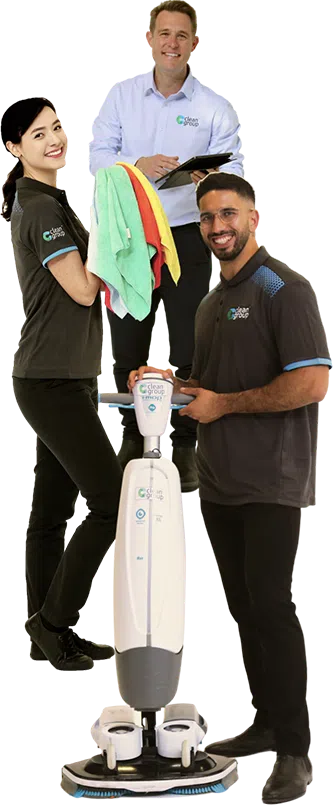Clean Group’s Essential Guide to Effective Office Cleaning Practices
In the bustling environment of today’s workplaces, maintaining cleanliness is paramount for productivity and employee well-being. Welcome to Clean Group’s comprehensive guide on office cleaning essentials. As experts in commercial cleaning, we understand the nuances of maintaining a pristine workspace. In this blog series, we’ll navigate through the dos and don’ts of office cleaning, offering practical tips and insights to ensure your workplace remains not only visually appealing but also hygienic and conducive to productivity. From tackling common challenges to implementing efficient cleaning routines, join us as we delve into the fundamentals of maintaining a spotless office environment. Let’s elevate your cleaning standards together!
Understanding the Importance of Office Cleanliness

An immaculate office space isn’t just about aesthetics; it’s a crucial factor in employee well-being and productivity. This section will delve into the multifaceted importance of maintaining a clean workspace. We’ll explore how cleanliness directly impacts employee health, reducing the spread of germs and allergens that can lead to illness and absenteeism. Moreover, a tidy office environment fosters a sense of professionalism and pride among staff, positively influencing morale and work ethic. Additionally, for businesses that frequently host clients or guests, a clean office serves as a reflection of the company’s values and standards. By understanding the broader implications of office cleanliness beyond surface-level tidiness, businesses can prioritize it as an essential aspect of their operations.
Dos: Essential Practices for Effective Office Cleaning
Effective office cleaning requires adherence to a set of essential practices that ensure a consistently clean and hygienic environment. In this section, we’ll outline these fundamental dos to guide your cleaning efforts. From dusting and sanitizing surfaces to emptying trash bins and restocking supplies, each practice plays a vital role in maintaining cleanliness. We’ll provide detailed explanations and practical tips for executing these tasks efficiently and thoroughly. By following these dos, businesses can create a healthier and more inviting workspace for employees and visitors alike. Consistent adherence to these practices not only improves cleanliness but also contributes to overall workplace satisfaction and productivity. Mastering these essential practices is key to establishing a successful office cleaning routine.
Don’ts: Common Mistakes to Avoid in Office Cleaning
Even with the best intentions, certain common mistakes can compromise the effectiveness of office cleaning efforts. This section will identify these pitfalls and provide guidance on how to avoid them. From neglecting high-touch surfaces to using improper cleaning products, we’ll highlight the most frequent errors that can undermine cleanliness. Additionally, inconsistent cleaning schedules and overlooking problem areas are common missteps that will be addressed. By being aware of these pitfalls and learning from them, businesses can refine their cleaning practices and maintain a consistently clean environment. Avoiding these common mistakes not only improves the cleanliness and hygiene of the office but also enhances overall operational efficiency and employee satisfaction. With proper awareness and diligence, businesses can sidestep these pitfalls and elevate their cleaning standards effectively.
Dealing with Office Clutter: Organization Strategies
Office clutter not only diminishes the visual appeal of a workspace but also hampers productivity and creates unnecessary stress. Tackling clutter requires effective organization strategies that promote efficiency and clarity.
- Implement a Clear Desk Policy: Encourage employees to keep their work surfaces tidy by only keeping essential items within reach.
- Utilize Storage Solutions: Invest in file cabinets, shelves, and organizers to provide designated spaces for documents, supplies, and personal belongings.
- Establish a Filing System: Develop a systematic approach to file organization, including categorization, labeling, and regular purging of outdated materials.
- Schedule Regular Cleanouts: Set aside time periodically to declutter common areas, desks, and storage spaces to prevent accumulation of unnecessary items.
- Foster a Culture of Minimalism: Encourage employees to adopt minimalist principles by prioritizing functionality over excess, leading to a more streamlined and efficient workspace.
By implementing these organization strategies, businesses can create a clutter-free environment that promotes productivity, creativity, and a sense of well-being among employees.
Eco-Friendly Office Cleaning: Sustainable Practices for a Greener Workplace
As environmental consciousness grows, businesses are increasingly seeking eco-friendly cleaning practices that minimize their carbon footprint and promote sustainability. Adopting green cleaning strategies not only benefits the planet but also contributes to a healthier workplace environment.
- Use Non-Toxic Cleaning Products: Choose cleaning solutions that are free from harsh chemicals and toxins to reduce indoor air pollution and protect the health of employees.
- Opt for Microfiber Cleaning Cloths: Replace disposable wipes with reusable microfiber cloths that effectively trap dirt and bacteria while reducing waste.
- Conserve Water and Energy: Implement water-saving techniques such as using low-flow faucets and energy-efficient cleaning equipment to minimize resource consumption.
- Recycle and Properly Dispose of Waste: Establish recycling programs for paper, plastics, and other recyclable materials, and ensure proper disposal of hazardous waste according to environmental regulations.
- Embrace Green Certification Programs: Seek certification from reputable eco-labels such as Green Seal or EcoLogo to demonstrate a commitment to sustainable cleaning practices and environmental stewardship.
By embracing eco-friendly cleaning practices, businesses can create a healthier, more sustainable workplace while reducing their environmental impact and contributing to a greener future for all.
Choosing the Right Cleaning Products and Equipment
Selecting appropriate cleaning products and equipment is crucial for achieving optimal cleanliness in an office environment. In this section, we’ll explore the factors to consider when choosing the right tools for the job. From evaluating surface materials to assessing environmental impact, we’ll provide guidance on making informed decisions. Additionally, we’ll discuss the importance of using products that are effective against germs and bacteria, particularly in high-traffic areas. Whether it’s selecting eco-friendly cleaning solutions or investing in advanced equipment, the choices made can significantly impact the overall cleanliness and health of the workspace. By understanding the role of different cleaning products and equipment options, businesses can make strategic investments that yield long-term benefits in maintaining a clean and sanitary office environment.
Creating a Customized Cleaning Schedule for Your Office
A customized cleaning schedule tailored to the specific needs of an office is essential for maintaining cleanliness effectively. In this section, we’ll guide you through the process of creating a personalized cleaning plan that aligns with your workspace requirements. We’ll discuss factors such as the size of the office, foot traffic patterns, and the type of work being conducted. By identifying cleaning priorities and allocating tasks accordingly, businesses can ensure that all areas receive the attention they need. Additionally, we’ll provide tips for scheduling regular maintenance tasks and incorporating flexibility to accommodate unexpected cleaning needs. With a well-designed cleaning schedule in place, businesses can streamline operations, minimize disruptions, and maintain a consistently clean and inviting office environment.
Tips for Maintaining Cleanliness in High-Traffic Areas
High-traffic areas present unique challenges when it comes to maintaining cleanliness in an office setting. In this section, we’ll share practical tips and strategies for effectively managing these bustling zones. From entryways and break rooms to corridors and communal spaces, we’ll address the specific cleaning needs of areas that experience heavy usage. Strategies such as increasing the frequency of cleanings, implementing barrier mats, and deploying quick-clean routines will be explored. Additionally, we’ll discuss the importance of proactive maintenance to address spills, stains, and other messes promptly. By implementing these tips, businesses can ensure that high-traffic areas remain clean, welcoming, and conducive to productivity. With targeted attention and strategic planning, even the busiest areas of the office can maintain a high standard of cleanliness.
Conclusion
Mastering the dos and don’ts of office cleaning is paramount for maintaining a healthy, productive workspace. By understanding the importance of cleanliness, implementing essential practices, and avoiding common mistakes, businesses can create an environment that promotes employee well-being and professional excellence. From choosing the right cleaning products to developing customized schedules and eco-friendly practices, Clean Group stands ready to support businesses in Sydney and beyond on their journey to pristine workplaces.
For expert guidance and professional cleaning services tailored to your specific needs, contact Clean Group today at 0291607469. Our dedicated team is equipped with the knowledge, experience, and eco-friendly solutions necessary to elevate your office cleaning standards and create a cleaner, healthier workplace environment. Let us partner with you to ensure that your office space reflects the professionalism and attention to detail that your business deserves.

